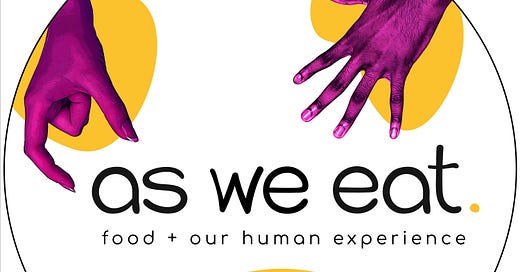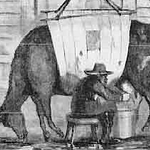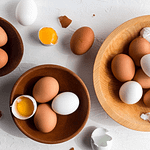Our cupboards are full of stories. In this installment of What’s in Your Pantry, we talk about a 4,000 year old spice, modern medicine, Lewis Carroll’s famous quote about flamingos and mustard, and an invasive species that marked safe passage.
When we pause to reflect, it’s somewhat a miracle that we have such great access to a whole world’s worth of spices. Some, like turmeric and mustard, have been a part of our diets for thousands of years and across a variety of food cultures.
Spicy History of Turmeric
When Leigh and Kim think of turmeric, the first thing that comes to mind is curry powder, but this brilliant spice goes far beyond Indian cuisines.
The use of turmeric dates back about 4,000 years to India, specifically to the Vedic culture where it was used in cooking, in religious ceremonies and prized for its medicinal properties.
Turmeric belongs to the ginger family. The compound that gives turmeric its signature color is curcumin. India is the largest producer and consumer of turmeric, using 80% of the crop.
Traditionally, the turmeric rhizomes were placed in pans, covered with water and leaves and a secret ingredient —— cow dung. They were steamed or boiled and then dried. That process is discouraged today for obvious reasons. Today, they’re boiled, dried in the sun, polished and then ground.
As a traditional, holistic medicine, turmeric has been used for centuries in many parts of the world.
Turmeric is a really important spice in Ayurveda - one the world’s oldest holistic healing systems originating in India - a topic we also discussed in Episode 9. Some of the properties ascribed to turmeric include: providing overall energy to the body; relieving gas; dispelling worms; improving digestion; regulating menstruation; dissolving gallstones; and relieving arthritis. In South Asian countries, it is used today as an antiseptic for wounds, burns, bruises; anti-inflammatory agent, gastrointestinal remedy; and to remedy skin conditions.
Even in modern medicine turmeric has been prescribed for various diseases - though that history is only about 100 years old vs. the 4,000 years of the traditional medicines just described. Herbal Medicine: Bimolecular and Clinical Aspects lists over 100 in vivo and clinical studies - in vivo is within an entire organism - of the therapeutic effects of turmeric on several cancers, skin tumors, neuronal, cardiac and kidney disorders, depression, inflammation, wound-healing, stimulation of bile flows, healing peptic ulcers with a conclusion that “Phytochemical analysis of turmeric has revealed a large number of compounds, including curcumin, volatile oil, and curcuminoids, which have been found to have potent pharmacological properties.”
Beyond its medicinal uses, the Hindu culture reveres turmeric as sacred. It is used in wedding ceremonies. A string that is dyed yellow is tied around the bride's neck by the groom similar to the exchanging of rings. In some parts of India, Bangladesh, and Pakistan, turmeric paste is applied to the skin of the bride and groom to make the skin glow.
It can be used as a dye. Buddhist robes are dyed with turmeric, and the turmeric color is associated with Lord Krishna. We both have also dyed a number of aprons and tea towels with turmeric - on accident.
Though not quite as auspicious as the Buddists robes or an association to Lord Krishna, turmeric is also used to color foods like cheese, butter, yellow cake mixes, ice cream, orange juice, cake icings, cereals, sauces, popcorn, yogurts, and yellow mustard.
Today we’re seeing turmeric being used in health and wellness communities for its natural healing properties … golden milk or turmeric tea, to white teeth, brighten skin. It’s even used in sunscreen formulas.
We talk at length about curries in Episode 9, but really Western eaters were introduced to turmeric through the British curry recipes of the mid-17th century. In addition to a curry recipe in Hannah Glasses 1747 cookbook, The Art of Cookery Made Plain and Simple is a recipe for “India pickle” made with turmeric.
“Flamingoes and Mustard Both Bite”
Mustard as we know it derives from mustard seeds; the plant is a member of the Brassica family. The condiment that we have come to love as a companion to all manners of sausages, frankfurters, hot dogs, weenies, and so much more is fairly simple: ground, bruised, or whole mustard seeds mixed with water, vinegar, lemon juice, wine, or other liquids and seasoned with salt and sometimes other spices creates a tangy and sometimes spicy sauce ranging in colour from bright yellow to dark brown.
The English word "mustard" derives from the Anglo-Norman mustarde and Old French mostarde. (Modern French is moutarde.) The first element is from Latin mustum ("must") because it was originally prepared by making a paste of ground mustard seeds and must, or unfermented grape juice. The second element comes also from Latin ardens (hot, flaming).
We commonly see mustard in one of four preparations:
Dijon mustard is ground mustard blended with white wine
English or yellow mustard contains turmeric which gives it the signature hue
Bavarian sweet mustard has a courser appearance
Whole seed mustard usually comprised of black mustard seeds
Although mustard plants are found all over the world, and there is evidence of mustard plants being cultivated in the Indus Valley until 1852 BC, it was the Romans who experimented with cooking with mustard seeds. The De re coquinaria, a Roman cookbook dating to the late 4th CE, contains a receipt for a glaze for spit-roasted boar that contains a mixture of ground mustard, pepper, caraway, lovage, coriander seeds, dill, celery, thyme, oregano, onion, honey, vinegar, fish sauce, and olive oil.
The reach of the Roman empire was vast and mustard seeds made their way to Roman Gaul which we now call France. Mustard makers appeared on the French Royal Registers in Paris in 1292 with the region of Dijon being a recognized center for mustard making. In 1877, the most famous Dijon mustard makers, Grey-Poupon, was established as a partnership between Maurice Grey, a mustard maker with a recipe incorporating white wine; and Auguste Poupon, his financial backer.
Mustard also made a stake in England - some say in Tewkesbury, and others say in Durham which as an 18th Century saying goes, is known for seven things: wood, water, pleasant walks, law, gospel, old maids and mustard.
In the 13th Century, mustard seeds were ground at the table and used to flavor meats that were beginning to rot. As food preservation techniques improved, mustard undertook a major transformation in 1720 when one “Mrs. Clements” allegedly invented a new method of extracting the full flavour from mustard seed by grinding the seeds in a mill similar to the process of grinding flour from wheat producing a very fine, smooth mustard. The story continues that King George the First (circa 1714) was delighted by this new English mustard and soon everyone in London was keen to follow royal fashion and have mustard at table. Rival mustard firms sprang up around the country, including London where Messrs Keen and Sons manufactured the product from 1742, supplying it to taverns and chophouses. This firm was acquired by Colmans of Norwich in 1814 and is memorialized in the saying "keen as mustard".
But another version attests that the early use of mustard as a condiment in England dates to 1390 in the book The Forme of Cury (written by King Richard II's master cooks) where mustard balls were composed from coarse-ground mustard seed combined with flour and cinnamon, moistened, rolled into balls, and dried—which were easily stored and combined with vinegar or wine to make mustard paste as needed. The town of Tewkesbury was known for its high-quality mustard balls, originally made with ground mustard mixed with horseradish, which were then exported to London and other parts of the country and mentioned in William Shakespeare's play King Henry the Fourth, Part II.
Sweet brown Bavarian mustard is made from kibbled mustard seed sweetened with sugar, apple sauce, or honey and was first created in 1854 by Johann Conrad Develey in Munich. It is typically served with Weisswurst, a traditional Bavarian sausage made from minced veal and pork back bacon, or Leberkäse is a rich meat loaf made from finely ground corned beef, pork, bacon and onions and baked till it forms a dark brown crust.
The finely milled, bright yellow mustard made popular in the United States by French’s made its debut at the 1904 World’s Fair in St. Louis. The mustard gets its distinctive sunny yellow from turmeric and it is the most commonly used mustard in the United States – and tied with Dijon in Canada. A very mild prepared mustard is regularly used to top hot dogs, sandwiches, pretzels, and hamburgers as well as an ingredient of many potato salads, barbecue sauces, and salad dressings.In Austria, it is called Amerikanischer Senf (American mustard), and is regarded as much milder than local varieties.
Stadium Mustard is made with only brown mustard seed. It is a mildly spicy brown mustard more similar to European mustards than American deli-style brown mustards. Stadium Mustard is unique in that it is homogeneously brown in color, compared to traditional coarse-ground brown deli mustards, which are typically mottled in appearance and may feature both yellow and brown mustard seeds. Originally served at the Cleveland Municipal Stadium, it is now served at 150 stadiums in the United States.
Other mustard variations include beer mustard, honey mustard, hot pepper mustard, and a whole host of mustards are made with alcoholic spirits like whisky, brandied peach, and cognac.
Mustard can be added to dishes as a primary spice, as is popular in East Indian cuisine. Added to mixed vegetables or fish curries, it can impart a unique flavour to some of the Indian recipes.
In the Netherlands and northern Belgium, mustard soup contains mustard, cream, parsley, garlic, and pieces of salted bacon.
MUSTARD SEED TRAIL
The story Kim learned about California’s wild mustard is that the seeds were brought to California in the early 18th Century from Spain. As Father Junipero Serra traveled from the region of San Diego north to San Francisco in 1713 , his party scattered mustard seeds to create the Camino Real. Every spring the mustard plants (actually considered an invasive species) bloom golden yellow to mark the path between the missions established along the way.
A historical marker at City Hall in Mission Viejo, California tells this story of the Mustard Seed Trail:
"In 1769 Gasper de Portolá led a group of Spanish soldiers on a thousand-mile march from Baja California to San Francisco. His purpose was to locate the ports of San Diego and Monterey and to establish a series of churches and military posts. The route he followed wandered north along the coast from San Diego, connected the sites of the Missions San Luis Ray, San Juan Capistrano, and San Gabriel; turned west to Los Angeles and then north through the Salinas Valley inland from Monterey; and at last reach the site of Mission San Francisco de Asís (popularly called Mission Dolores).
Because there were no roads in those days, it was easy for travelers to lose their way. According to legend, the Spaniards sowed wild mustard seeds as they walked, and that plant's yellow flowers marked the trail for their return and for others to follow. This thoroughfare linking California's presidios and missions was called El Camino Reál ("The Royal Road" or "The Kings Highway"), a designation given to roads that were public rather than private. It was used extensively by adventurers and traders, by explorers and settlers, by soldiers and priests. Today, light poles bearing mission bells remind travelers of the reason this road was established; and each spring, yellow blossoms once again bloom along the California Mustard Seed Trail."Copy
What’s In Your Pantry Transcript
🎧 Click here for the full, interactive transcript of this episode 🎧 {
Sources We Found Helpful for this Episode
Books We Think You’ll Enjoy Reading
Recipes You Really Need to Try
Episodes We Think You’ll Like
Dutch Ovens: Wedding Gifts, Symbols of Independence, and Members of the Family
Campfire Foods: Harnessing Fire, Foil Packets, and Food on Sticks
We would love to connect with you
AsWeEat.com, on Instagram @asweeat, join our new As We Eat community on Facebook, or subscribe to the As We Eat Journal.
Do you have a great idea 💡 for a show topic, a recipe 🥘 that you want to share, or just say “hi”👋🏻? Send us an email at connect@asweeat.com
Review As We Eat on Podchaser or Apple Podcast. We would like to know what you think.
And please subscribe to As We Eat, Going Places. Eric and Leigh will be traveling in their converted van sharing stories of food culture from the road.
We would love it if you would consider becoming a supporting subscriber. For just a few dollars, you can get access to exclusive content including our Recipe Box Roulette “card” game, more in-depth articles, more recipes and you’ll help keep our oven lights on!
Thank you for listening to the As We Eat Podcast. This post is public so share it with a friend - or three :)
As an Amazon Associate and member of other affiliate programs, we earn from qualifying purchases at no additional cost to you. This helps us to continue to bring you stories, history, and personal musings about food, cuisines, traditions, and recipesOur cupboards are full of stories.


























Share this post